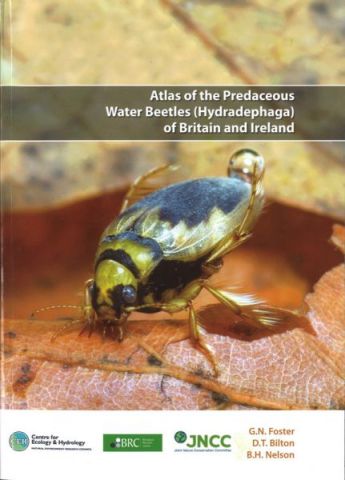New and upcoming publications
Atlases and publications
-
The Atlas of the Predaceous Water Beetles is now available (the second volume is in press): Foster, G.N. et al., (2016) Atlas of the Predaceous Water Beetles (Hydradephaga) of Britain and Ireland. FSC Publishing. This atlas includes the predaceous water beetles, or Hydradephaga – the whirligig beetles (Gyrinidae), the crawling water beetles (Haliplidae), one species of squeak beetle (Paelobiidae), the burrowing water beetles (Noteridae), and the diving beetles (Dytiscidae). One hundred and fifty-four species are reviewed here, 152 of them from Britain, 113 from Ireland, and 72 from the Isle of Man, with an additional two recorded only from the Channel Isles.
- Provisional atlas of the aculeate Hymenoptera of Britain and Ireland - Part 10 is now in press. Part 10 of the Provisional Atlas of aculeate Hymenoptera marks the completion of the BWARS atlas series. It was always intended to cover the British species in ten parts and whilst this part covers some species that are widespread and common it also includes some that are restricted to the Channel Islands, as well as some that have only been recorded from Britain on a few occasions. In this tenth part of the Provisional Atlas, 50 species are added, taking the total number mapped to 567.
- A draft atlas for the Soldierflies and Allies Recording Scheme has been published as a PDF, available from the BRC-hosted scheme website: Harvey, M.C. 2018. Provisional atlas of soldierflies and allies. The maps are based on data from the recording scheme database (including data from iRecord) up to 15 January 2018 (just over 100,000 records), plus additional data from numerous sources as displayed on the NBN Atlas at February 2018 (just over 50,000 records). Around 3,000 people have contributed records over the past 200 years.
-
BRC is in discussion with David Clements of the conopid fly recording scheme (Diptera: Conopidae) to look at options for producing an atlas in the not too distant future. This is in the early stages at the moment, but now would be a good time to start sorting out your records to send to David!
-
We are delighted to announce the forthcoming publication of Beetles of Hertfordshire by the County Recorder for Hertfordshire, Trevor James, through the Hertfordshire Natural History Society. It includes accounts of all 2,483 species of beetle so far recorded in Hertfordshire and will be published by the HNHS in the summer of 2018.
- Field Guide to the Ladybirds of Great Britain and Ireland will be published towards the end of 2018. It covers all 47 species of ladybird occurring in Britain and Ireland in an easy-to-use format. Each species account includes a description of field characters, similar species, life-cycle, food source, habitat and distribution. The guide also covers natural enemies and community interactions, as well as potential new arrivals. It is beautifully illustrated by Richard Lewington.
Research articles
Evidence suggests that neonicotinoid use is linked to large-scale and long-term decline in wild bee species distributions and communities. The research used data provided by Fera Science Ltd and the Bees, Wasps and Ants Recording Society, examined changes in the occurrence of 62 wild bee species with oilseed rape cropping patterns across England between 1994 and 2011 - the time period spanning the introduction of wide-scale commercial use of neonicotinoids. The decline was, on average, three times stronger among species that regularly feed on the crop such as Buff-tailed bumblebee (Bombus terrestris) compared to species that forage on a range of floral resources, indicating that oilseed rape is a principle mechanism of neonicotinoid exposure among wild bee communities. Read more…
Helen Roy, an ecologist from CEH who specialises in invasive alien species such as the Harlequin ladybird, joined an international team of researchers who have demonstrated that globalisation could be fuelling an unprecedented increase in alien species. The study includes datasets on non-native species from around the world including the GB Non-native Species Information Portal, which has been developed by Helen and her team and includes lots of information provided by the recording community. Read more…
